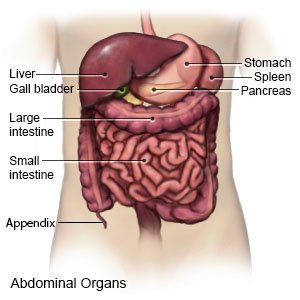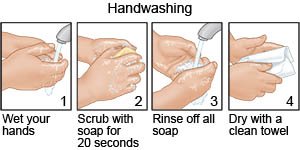Laparoscopic Appendectomy in Children
Medically reviewed by Drugs.com. Last updated on Apr 6, 2025.
Laparoscopic appendectomy is surgery to remove your child's appendix. The surgery is done through small incisions in your child's abdomen. Gas used during surgery may cause shoulder or chest pain. This is normal and should go away in a day or two.
 |
DISCHARGE INSTRUCTIONS:
Call your child's pediatrician or surgeon if:
- Blood soaks through your child's bandage.
- Your child feels full and cannot burp or vomit.
- Your child cannot eat or drink anything.
- Your child has increasing swelling in his or her abdomen.
- Your child has a foul-smelling odor coming from an incision wound, or it is draining fluid.
- Your child's wound is red, swollen, or has pus.
- Your child's vomit is greenish, looks like coffee grounds, or has blood in it.
- Your child is not able to have a bowel movement.
- Your child has a fever.
- Your child has chills, a cough, or feels weak and achy.
- Your child has nausea or is vomiting.
- Your child's pain is not helped with medicine.
- You have questions or concerns about your child's surgery, condition, or care.
Medicines:
Your child may need any of the following:
- Antibiotics help prevent or fight a bacterial infection.
- Prescription pain medicine may be given. Ask your child's healthcare provider how to give this medicine safely. Some prescription pain medicines contain acetaminophen. Do not give your child other medicines that contain acetaminophen without talking to a healthcare provider. Too much acetaminophen may cause liver damage. Prescription pain medicine may cause constipation. Ask your child's healthcare provider how to prevent or treat constipation.
- Do not give aspirin to children younger than 18 years. Your child could develop Reye syndrome if he or she has the flu or a fever and takes aspirin. Reye syndrome can cause life-threatening brain and liver damage. Check your child's medicine labels for aspirin or salicylates.
- Give your child's medicine as directed. Contact your child's healthcare provider if you think the medicine is not working as expected. Tell the provider if your child is allergic to any medicine. Keep a current list of the medicines, vitamins, and herbs your child takes. Include the amounts, and when, how, and why they are taken. Bring the list or the medicines in their containers to follow-up visits. Carry your child's medicine list with you in case of an emergency.
Drugs used to treat this and similar conditions
Sandostatin
Sandostatin is used to treat acromegaly and to reduce flushing episodes and watery diarrhea caused ...
Sandostatin LAR Depot
Sandostatin LAR Depot is used for acromegaly, carcinoid tumor, vasoactive intestinal peptide tumor
Omvoh
Omvoh is used to treat moderate to severe ulcerative colitis or Crohn's disease in adults. This ...
Bynfezia Pen
Bynfezia Pen (octreotide) is used to treat acromegaly and to reduce flushing episodes and watery ...
Octreotide
Octreotide systemic is used for acromegaly, carcinoid tumor, diabetes, type 1, diarrhea, dumping ...
Care for your child:
- Apply ice on the incision wounds. Ice helps prevent tissue damage and decreases swelling and pain. Use an ice pack, or put crushed ice in a plastic bag. Cover it with a towel before you apply it to your child's skin. Apply ice for 15 to 20 minutes every hour or as directed.
- Have your child rest to help with healing. Follow directions from his or her healthcare provider. Directions include when your child can return to school or other daily activities. This will take 1 to 2 weeks, depending on if the appendix ruptured. Your child may not be able to play sports or go to gym class for 2 to 4 weeks.
- Help your child protect the surgery wounds until they heal. Do not let your child lift anything heavier than his or her healthcare provider says is okay. Have your child hug a pillow when he or she needs to cough or sneeze.
- Help your child prevent or relieve constipation. Constipation may make your child strain to have a bowel movement. The strain cause damage before your child has healed. Have your child drink extra liquids during the day. Give your child high-fiber foods. High-fiber foods include fruits and vegetables, whole-grain breads and cereals, and cooked beans.

Incision wound care:
- Wash your hands before you care for the incision wounds.

- Check the wounds each day for signs of infection, such as swelling, redness, or pus.
- Keep the wounds clean and dry. You may need to cover the wounds when your child bathes so they do not get wet.
- Carefully wash the wounds with soap and water, or as directed. Dry the wounds and put on new, clean bandages.
- Change the bandages when they get wet or dirty. The strips of medical tape will fall off on their own. If they do not fall off within 10 days, you can gently peel them off.
Follow up with your child's pediatrician or surgeon as directed:
Write down your questions so you remember to ask them during your visits.
© Copyright Merative 2025 Information is for End User's use only and may not be sold, redistributed or otherwise used for commercial purposes.
The above information is an educational aid only. It is not intended as medical advice for individual conditions or treatments. Talk to your doctor, nurse or pharmacist before following any medical regimen to see if it is safe and effective for you.
Further information
Always consult your healthcare provider to ensure the information displayed on this page applies to your personal circumstances.
